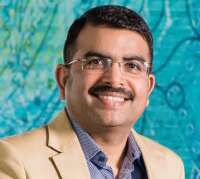
MD and CEO
Fino Payments Bank
The pandemic has been an epic test of character and determination for millions of people around the world. Nothing compares with the sacrifice of workers on the front lines in hospitals and other essential services.
In the business context, CEOs have had to cope with extraordinary demands. We have witnessed CEOs creating a narrative about their leadership agenda when they first move into the job. In the current scenario, the narratives are being updated to help employees, customers, and stakeholders make sense of their actions.
For Rishi Gupta, MD and CEO at Fino Payments Bank the crisis has been an ultimate test of leadership, and he seems rather energized by these challenges and feels closer than ever with his team. “Having a clear line of communication during a time in which there are still so many unknowns is extremely important,” he says.
In this conversation with Ashwani Mishra, Editor, CXODigitalPulse.com, Rishi shares his perspective on how he and his organization are adapting to change, how the bank has been focusing on improving customer experience and more importantly what it means to be a CEO in the midst of a pandemic.
Excerpts:
Q. As the MD and CEO, you have a responsibility to hear and respond to the needs of your customer and your employees. They need to be at the heart of every decision you make today. Although many of these decisions may still largely be centered around business strategy, credit-risk assessments, and technology. How are you moving out of this crisis stronger by listening, analyzing, and making employee- and customer-centric decisions?
The occurrence of an event like Covid happens once in a century. In such a scenario the requirement of the banking ecosystem becomes even more important. Being a bank and operating under the essential services category, we had to ensure that we continue offering services for our customers without any interruption.
And at the same time, we had to move the safety, health, and financial well-being of our employees to the forefront of our decision-making. The internal leadership team worked closely, and we anticipated the changes that were required to be brought in and allocated our resources accordingly. The mantra for us has been to “communicate, communicate and communicate,” with all our employees, and at all times. I am glad to share that we did not take any knee-jerk reactions during the initial days of the crisis.
In times like this, it is important to “be human” than being a CEO. The more human you are with your team, the more trust and empathy they lend to you. There is a better understanding and that gives you the ability to do so much more.
Q. Has the crisis also presented an opportunity to reset how work gets done, in ways that makes it multiple times more efficient and effective? Also, what has been your efforts to remain relevant and adapt to changing consumer behaviours?
Absolutely. The first phase of the lockdown was our opportunity to significantly accelerate the adoption of our digital initiatives. The importance of becoming more digital was already obvious pre-COVID, but its onset has exponentially catalyzed the need. What we had planned to achieve over the next couple of years was made possible in the first few months of the pandemic itself. A lot of digitization has happened internally with an increased focus on automation.
Post-COVID, the world has changed. Customers are now seeking safe, personal banking solutions. We gave customers an alternate channel to carry out their banking activities. We developed a 3M strategy for always available banking services for customers that enables them to move money via mobile apps or through our merchant points.
Through our “Fino Hamesha” initiative we have onboarded thousands of merchants as our banking points. We have tied-up with neighborhood stores, dairy outlets, medical stores, etc. that are always open and available for customers. The Alternate Banking Channels today have become more prevalent, and the growth in these channels will continue.
Improvement in customer service will continue to be our focus. We have created a CSR (Convenience, Simplicity and Respect)-model for our customers. The idea is to offer convenience in terms of reaching out to use our services/transactions via mobile or merchant outlets, simplicity in onboarding customers, easy-to-use apps, and finally respect, which all customers deserve.
Q. What are some of the beliefs or long-held assumptions that you will need to clearly reset to achieve growth? What will you say “no” to, or stop doing, to create that additional space to move faster and get bigger?
We are not looking at short-term measures or gains. All our actions and initiatives will have a clear focus on long-term sustainability.
One change that we have consciously made is to move out from a high fixed cost model to a lower operating cost model.
Q. What will be some key technology areas or solutions that you will be focusing on in the near term?
Digital solutions have to enable the business to move faster, and we want to focus on future-proof technologies for any new products we may launch or new markets we may go after.
Data for us is extremely valuable that can help us steer through unpredictable environments. We will also look out for technology solutions around payments, lending, and improving customer experience.
Social distancing translates into restrictions on mobility and ways of working for both customers and employees. So, there is an increasing preference for contactless banking and remote working.
We are working on digital onboarding enabled by video-KYC to help drive new customer acquisition that offers cost efficiencies and lowers turnaround time. We will also be looking at iris recognition for authentication.
Data security is a concern and strengthening our security posture will be another key focus area for us.




